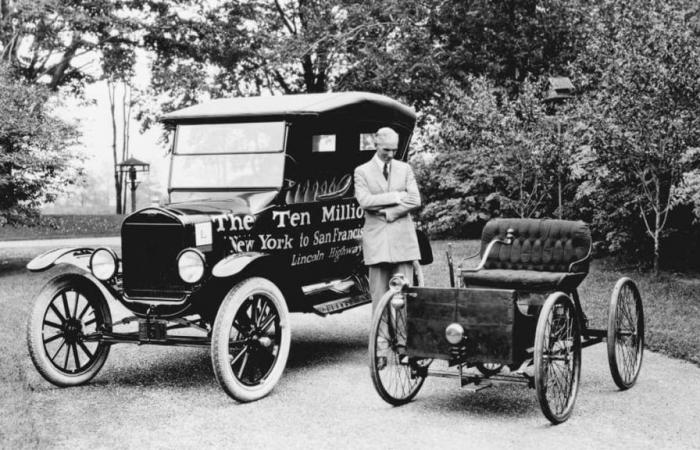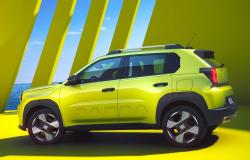The mass production revolution
One of Henry Ford’s greatest achievements was the introduction of assembly lines in its factories, inspired by the practices of other industries. Ford implemented this system in 1913 at its Highland Park plant. Line production allowed each worker to be dedicated to a specific task, increasing efficiency and reducing costs.
This innovation not only sped up production, but also drastically reduced the price of cars. By 1924, the price of the Model T had dropped to 260 dollars. Ford’s mass production not only revolutionized the automotive industry, but also influenced other industrial sectors around the world.
Henry Ford, an adventurous and eccentric businessman
Henry Ford was a singular figure, known as much for his innovations as his eccentric personality.
Before founding the company that revolutionized the car business in the world, in 1896 he built one of the first vehicles that circulated in the United States: the quadricycle Ford.
Over the years improvements were made until in 1903 he sold the car to buy it again a year later for a cheaper price. It is currently in the Henry Ford Museum in Michigan.
One of Henry Ford’s most surprising decisions was increase the salary of its workers at $5 a day in 1914, double the industry average.
This decision, which at the time was criticized by other businessmen, had a clear purpose: to reduce high employee turnover and increase efficiency. Ford believed that if he paid his workers well, they could afford to buy the cars they made, creating a market for his products. Furthermore, he gave them a paid leave of two days a week, so they could enjoy the vehicles. This strategy proved to be successful and was adopted by other industries in the following decades.
The first models, from the Ford T to electricity
In its early years, Ford launched a series of experimental models that helped establish the company’s foundation. However, it was the launch of the Model T in 1908 which forever changed the automotive industry and the perception of the automobile in society.
The introduction of the moving assembly line in 1913 allowed Ford to produce automobiles at unprecedented speed, reducing vehicle assembly time from 12 hours to just 90 minutes.
This technology not only lowered costs, but also made it possible for millions of people to afford to own a car, transforming personal mobility and the social structure of the United States.
After the success of the Model T, Ford launched the Model A in 1927. Although it did not achieve the same fame as its predecessor, the A was a significant success and represented a breakthrough in terms of design and technology. It incorporated a more powerful engine and modern features such as hydraulic brakes.
FORD A.jpg
During the Great Depression, Ford, like other automotive companies, faced significant economic challenges. However, the company adapted and took advantage of the situation of the Second World War by producing military vehicles and other special equipment. This diversification not only helped Ford survive difficult times, but also strengthened its position as a pillar of the American automotive industry.
In 1948 Ford launched F series, one of the most successful in its history. Are trucks, Known for their durability and versatility, they remained top sellers in the United States for more than four decades.
Introduced in 1955, the Ford Thunderbird It was a response to the Chevrolet Corvette and ushered in a new era for luxury sports cars. With its sleek design and powerful engines, the Thunderbird quickly became a symbol of status and sophistication, capturing the imagination of the American public.
Launched in 1964, the Ford Mustang He became an almost instant icon. This “pony car” captured the spirit of a generation with its sporty design, affordable price and great performance. The Mustang became a symbol of youth culture and American freedom.
FORD MUSTANG.jpg
He Ford Escort It was launched in 1968. It was initially designed for the European market, but its success soon spread globally and thus became one of Ford’s best-selling cars, especially in Europe and Latin America. Through several generations, the Escort remained a favorite among drivers looking for a practical and economical car.
He Ford Taunus, launched in 1939 and aimed at the European market, became one of the company’s most popular models. Its production continued until 1982, when it was discontinued.
The Advancement Towards Electricity
In the last decade, Ford has focused on the development of electric and hybrid vehicles, in response to the growing demand for more sustainable transportation solutions. Along these lines, it introduced models such as the Ford Focus Electric, the Ford Fusion hybrid and, more recently, the Ford Mustang Mach-E.
He Mustang Mach-E, Launched in 2020, it represents a fusion of Ford’s iconic heritage with the demands of the future. This all-electric SUV combines the design and performance associated with the Mustang name, but with the efficiency and advanced technology expected from a modern electric vehicle.
In 2021, Ford introduced the electric version of its best-selling truck, the F-150 Lightning. This model not only maintains the robustness and capacity that has always characterized the F series, but also introduces innovations such as the ability to power a house in an emergency and impressive performance with its electric drivetrain.
Ford’s arrival in Argentina
Ford Motor Company arrived in Argentina in 1913, just a decade after its founding in the United States. Ford’s first assembly plant in Argentina was established in the neighborhood of La Boca. This plant was dedicated to assembling vehicles from parts imported from the United States. In its early years, the La Boca plant produced a small number of vehicles, but demand grew rapidly.
In 1925, Ford inaugurated a new plant in La Boca, with a much greater production capacity. This plant became one of Ford’s most important plants outside the United States. During the 1930s and 1940s, Ford Argentina expanded its product line, including trucks and tractors, adapting to the needs of the local market.
On September 21, 1961, Ford Argentina inaugurated its new factory located in General Pacheco, where it concentrates its operations in the country. The new industrial center demanded an investment of 70 million dollars in 1960: the largest investment in that area that Ford had made until then outside the United States.
The iconic models from the General Pacheco plant
In its more than half a century of existence, Planta Pacheco has seen models leave its production lines that have remained in the memory of Argentines: the Falcon, Fairlane, Taunus, F-100, Sierra, Escort and the most recent global vehicle, equipped with innovative and intelligent technology, made available to Argentine customers from the entry versions: the New Ranger.
FORD FALCON ARGENTINA.avif

Ford Falcon: Introduced in the 1960s, the Falcon became an icon of the Argentine automotive industry. With its robust and reliable design, the Falcon won the hearts of Argentines and became a symbol of status and prestige.
Ford Taunus: Another jewel in Ford’s crown in Argentina, the Taunus combined style, performance and comfort in a single vehicle. Since its launch in the 1970s, the Taunus has positioned itself as one of the most desired models in the Argentine market.
Ford Ranger: With the rise of pickup trucks in Argentina, the Ford Ranger stood out as a reliable and versatile option for those looking for a vehicle capable of facing all types of challenges. Since its introduction in the 1990s, the Ranger has been a bestseller and a constant presence on Argentine roads.







